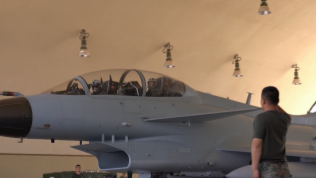By Chen Hanghui and Qin Fangfei
Recently, the Pentagon announced the Fiscal Year 2026 Defense Budget, totaling around one trillion dollars. Analysts point out that this new defense budget exposes the dangerous trend of the US clinging to militarism and accelerating preparations for war, which deserves high vigilance from the international community.
New Record in Defense Budget
For a long time, the US has regarded military hegemony as a key pillar of its global dominance, continuously increasing defense spending year after year. In May this year, the US Department of Defense, for the first time, submitted its FY2026 defense budget request in the form of "one budget, two bills." The request submitted to the House of Representatives and the Senate amounts to $848.3 billion. In addition, the "One Big Beautiful Bill Act" includes $157 billion defense funding, with $113.3 billion planned for FY2026. This means the actual total defense budget request for the Department of Defense stands at $961.6 billion for FY2026. Factoring in defense-related funding requested by other departments, the overall US defense budget will exceed $1.01 trillion.
Compared with previous years, the FY2026 Defense Budget has two notable features. First, it marks a significant year-on-year increase. The requested budget is about $110 billion higher than the previous fiscal year, an increase of more than 13%. The other is that defense spending as a share of the federal discretionary budget has risen sharply. According to statistics, from FY2024 to FY2026, the share of the U.S. defense budget in the federal discretionary budget has risen from 47% to 57%, exposing the Trump administration's strategic choice of prioritizing "security over people's livelihoods."
Pursuing Overwhelming Superiority
The US is dramatically boosting its nuclear budget to accelerate the modernization of its nuclear triad. For FY2026, the Pentagon requests $60 billion for nuclear forces, up 22% year-on-year. This funding will mainly support the research and procurement of new delivery platforms and strike munitions, including Columbia-class ballistic missile submarines, B-21 strategic bombers, LGM-35 Sentinel intercontinental ballistic missiles, and sea-launched nuclear cruise missiles. The goal is to build a next-generation nuclear triad by 2040 to strengthen the US strategic deterrent.
The budget also aims to maintain a high level of combat readiness to ensure that the US troops are prepared to fight at any time. The Pentagon plans to spend $160 billion on force readiness and training in FY2026, an increase of 22%, to further enhance combat capability. Analysts point out that this funding will not only support hundreds of joint exercises and large-scale theater-level drills but also help expand production capacity for critical munitions and weapon systems, laying the groundwork for a defense industrial base geared toward major power conflict.
The Pentagon will accelerate its push for intelligent warfare capabilities to gain an edge in smart combat. For the first time, the Department of Defense has created a dedicated smart warfare budget line, with $13.4 billion allocated for the development of intelligent weapons systems and software, including $9.4 billion for unmanned aerial vehicle procurement, $1.7 billion for the R&D of unmanned surface vessels, and $1.2 billion for intelligent command-and-control software development.
The Pentagon hopes to strengthen military technological innovation to secure the transgenerational advantage. In FY2026, the US Department of Defense plans to allocate over $170 billion for research, development, testing, and evaluation activities, representing an increase of more than 20% compared with FY2024. The aim is to accelerate technological innovation and ensure that new technologies move swiftly from the test range to the battlefield.
Fueling Global Arms Race
The US remains the world's largest military spender, accounting for roughly 40% of global defense expenditure. Yet its political and military leadership remains unsatisfied, dramatically increasing defense spending under the banner of "pursuing peace through strength." This exposes a security strategy rooted in power politics and reveals the strategic anxiety of a nation whose ambitions outpace its actual capabilities.
Washington is also demanding that its allies ramp up defense spending to bankroll its hegemonic ambitions. At the recent NATO summit in The Hague, the Trump administration pushed NATO members to raise defense spending targets from around 2% of GDP to as high as 5%.
In reality, the so-called "peace" that the US promotes is nothing but "Pax Americana", an obsession with hegemonic dominance. The essence of "pursuing peace through strength" is "protecting hegemony through strength." Such self-serving actions inevitably draw opposition from countries that reject hegemony and will likely push other nations to increase their own defense spending to counterbalance US ambitions, thereby fueling a new global arms race.













